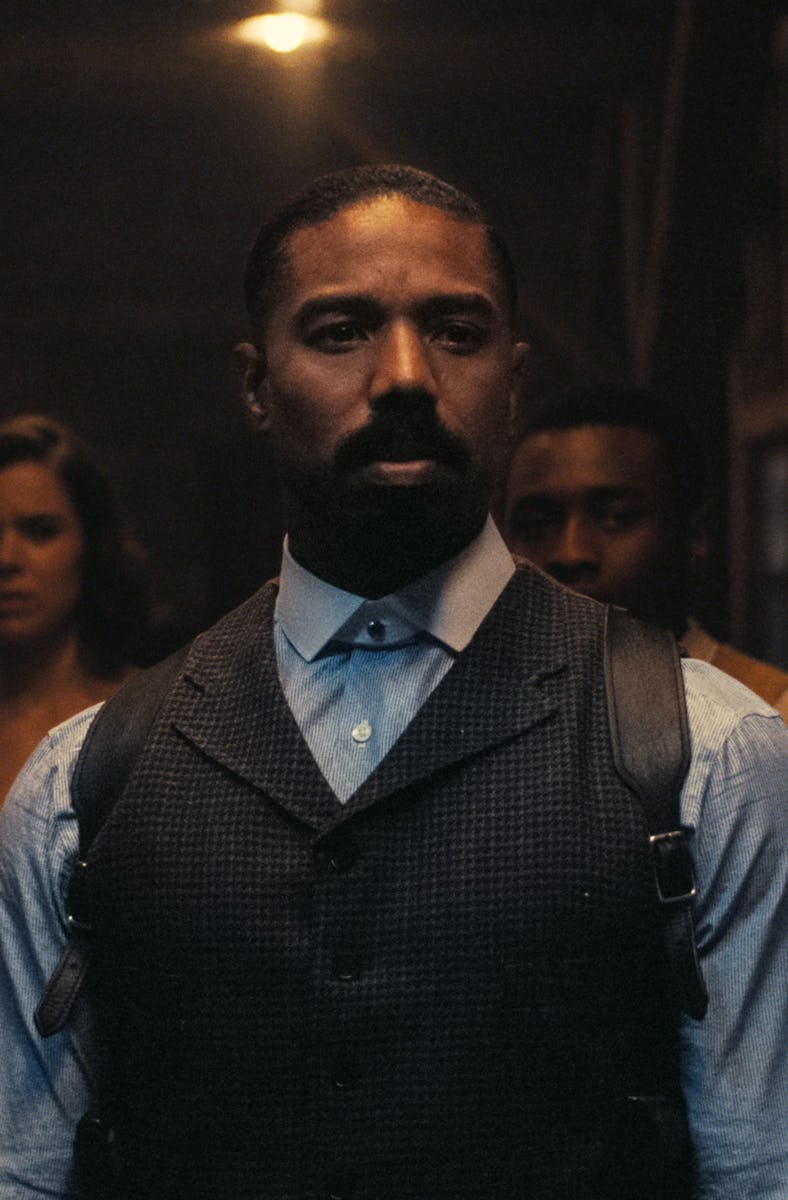Sinners Redefines An Iconic Vampire Trope
Ryan Coogler's modern horror masterpiece makes its streaming debut — the vampire genre will never be the same.

“Enter all ye who seek knowledge.”
For most people, those six words may seem innocuous — even welcoming — but for fans of Buffy the Vampire Slayer, they’re likely to send shivers down your spine.
The scene we’re referencing comes during a climactic plotline in Buffy Season 2. After Angel (David Boreanaz) transforms into the evil vampire Angelus, the gang comes up with a plan to restore his soul. But before they can, Angelus shows up at their high school headquarters to stop them. When asked how he got into the building without an invitation, the vampire quotes the Latin saying written on a sign outside: Formatia trans sicere educatorum (translation: Enter all ye who seek knowledge). “What can I say? I'm a knowledge seeker,” he explains with a deadly grin.
The “invitation rule,” which states that a vampire can’t enter a home or other building unless someone explicitly invites them inside, has been a mainstay of the genre for over a century. However, one of the smartest takes on the invitation rule comes from the 2025 film Sinners, which mixes the classic trope with a nuanced portrayal of race relations in 1930s America to cook up something truly unique.
After a record-breaking theatrical run, Sinners is streaming now on Max. Whether you’ve never seen it before or you’ve already watched it multiple times on the big screen, it’s worth revisiting this modern horror classic. But you may enjoy it even more after learning a bit more about the vampire trope at the center of director Ryan Coogler’s hit film.
“I revoke my invitation!”
The origins of the invitation rule predate vampires themselves. Early Slavic culture viewed the entryway of a home as a sacred space that evil creatures (like witches) couldn’t enter without an invitation. As Christianity spread through Europe, this concept was reinforced by beliefs that the home was imbued with holy power, which kept unholy beings at bay.
It wasn’t until 1897 that Bram Stoker’s Dracula codified the rule and ensured it would forever be associated with vampires. In the novel, the vampire hunter Van Helsing explains: “He may not enter anywhere at the first, unless there be some one of the household who bid him to come; though afterwards he can come as he please.” In the book, this is a relatively minor detail, but it has formed the bedrock for some of our most popular modern vampire stories.
Stephen King’s 1975 novel Salem’s Lot frequently references the rule and even attempts to subvert it, with one character declaring, “I revoke my invitation!” The 1985 film Fright Night also hinges on the trope, including a terrifying scene where the protagonist's mother inadvertently invites the vampire into their home.
In all these examples, and countless others, the invitation rule is a powerful narrative device because it creates a false sense of security. The good guys may feel safe inside knowing the vampires can’t force their way through the door, but inevitably, they’ll either get outsmarted or make a stupid mistake and invite the monsters in. The bloodshed that follows only feels worse when you know it’s self-inflicted.
“So why don't you go ahead and invite us in?”
Jack O’Connell’s lead vampire still has to obey the rule invitation.
The invitation rule sits at the core of Sinners, which takes place primarily during the opening night of a juke joint in 1930s Mississippi. The new club is owned by Smoke and Stack, twin brothers played by Michael B. Jordan, and their clientele is exclusively Black. That’s unsurprising given the film’s setting in America’s segregated South, but it suddenly becomes an issue when a trio of white musicians show up at the front door and ask to be invited in.
The trio, led by Jack O'Connell, are also vampires. But Smoke and Stack don’t know that, and neither does their bouncer, Cornbread (Omar Benson Miller). And yet, the vampires are unable to get inside. Standing in the doorway of the juke joint, they ask for hospitality in the name of good race relations and togetherness. But our protagonists refuse, worrying that if anything goes wrong, the police will show up (or worse, the Klan) and automatically blame the Black people. In this moment, it's America’s long history of racism and inequality that counterintuitively protects the good guys.
Of course, that only lasts so long. Sinners is a vampire movie after all, and that means someone inevitably needs to make a dumb decision that lets the vampires inside. This leads to several more interactions in which various characters are turned into vampires and suddenly need to be invited back into the club. At one point, even the bouncer suddenly can’t get into the juke joint, leading to one of the movie’s funniest interactions as he tries to B.S. his way inside and, moments later, delivers its most effective jump scare.
Smoke fires after seeing his brother Stack attacked.
It’s worth noting that Sinners isn’t the first movie to combine the vampire invitation rule and the club bouncer trope to clever effect. What We Do in the Shadows (the original movie, not the spinoff show) also features a scene where its pitiful vampires struggle to get inside a nightclub. But while director Taika Waititi’s mockumentary plays this for laughs, Ryan Coogler finds a way to infuse that same interaction with tension, terror, and racial dynamics all at once.
It’s just one example of how Sinners takes a genre we’re all familiar with and elevates it in surprisingly brilliant ways. Even after more than a century of stories about vampires who are seemingly too polite to barge into your home uninvited, Coogler’s movie finds new depth in this classic horror trope.
That alone is enough to rank Sinners right next to Dracula and Buffy the Vampire Slayer in the vampiric storytelling hall of fame.